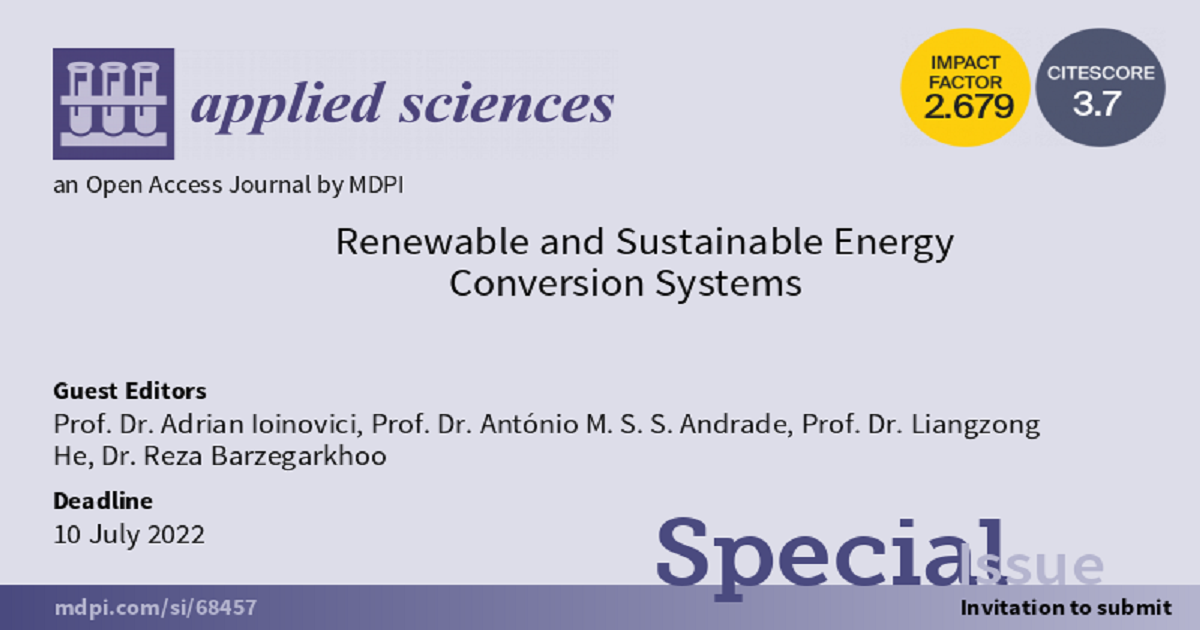Renewable and Sustainable Energy Conversion Systems
A special issue of Applied Sciences (ISSN 2076-3417). This special issue belongs to the section "Energy Science and Technology".
Deadline for manuscript submissions: closed (10 July 2022) | Viewed by 13797

Special Issue Editors
2. Faculty of Electric and Electronics Engineering, Holon Institute of Technology, Holon 5810201, Israel
Interests: energy conversion; power electronics
Special Issues, Collections and Topics in MDPI journals
Interests: DC-DC power converter; bidirectional converters; high step-up converter; renewable energy systems
Interests: wireless power transfer; DC-DC converters; multilevel inverters; fractional order; switched-capacitor converter; Z-source converter; high step-up converter
Interests: electrical & electronics engineering; power electronics; power converters; renewable energy technologies
Special Issue Information
Dear Colleagues,
Evolving, innovative energy conversion systems are playing an increasingly critical role in the meeting of future energy needs and the transition from classical, pollutant energy sources towards a greener, smarter, and sustainable development.
Environmentally friendly energy sources like solar, wind, or fuel cells, used either as front end of the national grid or as power supplies to standalone loads provide a variable energy, which depends on natural factors. They have to be accompanied by converters or inverters able to regulate their delivered power.
Green cells impose tough requirements on the power electronic circuits which follow them. The energy conversion has to be accomplished with a high efficiency. A new era of developments of power electronics was opened to meet the demands due to the new sources of energy.
The aim of the present Special Issue is to attract original high-quality papers and review articles proposing advances in sustainable energy conversion systems. Major topics include, but are not limited to:
- DC-DC converters supplied by green sources of energy
- Switched-capacitor converters for renewable energy
- DC-AC inverters supplied by environmentally friendly sources of energy
- Switched-capacitor inverters and AC-AC regulators for renewable energy cells and high frequency distribution line application
- Soft-switching for high switching frequency operation
- Smart grid supplied by renewable power sources
- Energy harvesting for smart applications
- Wireless power transfer for distributed energy systems
- Transformerless grid-tied micro inverters supplied by the renewable power sources
- Common-grounded DC-AC inverters with the single-stage static and/or dynamic voltage boosting gain suitable for renewable energy applications
- New energy electric vehicle technology
- Stability analysis for distributed new energy systems
- Control technology of power quality and stability based on switched-capacitor gene for distributed new energy systems
- Power converter reliability, power density, and costs for renewable energy systems
Prof. Dr. Adrian Ioinovici
Prof. Dr. António M. S. S. Andrade
Prof. Dr. Liangzong He
Dr. Reza Barzegarkhoo
Guest Editors
Manuscript Submission Information
Manuscripts should be submitted online at www.mdpi.com by registering and logging in to this website. Once you are registered, click here to go to the submission form. Manuscripts can be submitted until the deadline. All submissions that pass pre-check are peer-reviewed. Accepted papers will be published continuously in the journal (as soon as accepted) and will be listed together on the special issue website. Research articles, review articles as well as short communications are invited. For planned papers, a title and short abstract (about 100 words) can be sent to the Editorial Office for announcement on this website.
Submitted manuscripts should not have been published previously, nor be under consideration for publication elsewhere (except conference proceedings papers). All manuscripts are thoroughly refereed through a single-blind peer-review process. A guide for authors and other relevant information for submission of manuscripts is available on the Instructions for Authors page. Applied Sciences is an international peer-reviewed open access semimonthly journal published by MDPI.
Please visit the Instructions for Authors page before submitting a manuscript. The Article Processing Charge (APC) for publication in this open access journal is 2400 CHF (Swiss Francs). Submitted papers should be well formatted and use good English. Authors may use MDPI's English editing service prior to publication or during author revisions.





